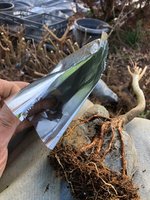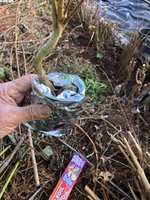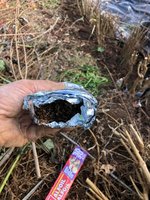gooeytek
Shohin
This is great, I'm definitely trying it!At one stage I got hold of a catering pack of foil which was not only a bulk pack but also appeared to be thicker and stronger. Currently using ordinary household foil from the supermarket. Try to get the thicker and stronger foil if you have an option. It is surprising how easily a small root will pierce the foil while I'm wrapping the roots. Needs to be thin and flexible enough to mould into all the hollows and cavities of your rock without breaking while still strong enough to hold the roots on the rock.
Standard rolls are wide enough to fold the foil in half to wrap with a double layer on all but the biggest rocks. I still wrap with around 2-3 layers of the doubled foil. In 12 months the outside layer is virtually dissolved so having several layers is worth the little extra foil.
Some more of the field grown trees out this afternoon but a bit too late for more photos.
Do you add any soil or medium in the foil pouch at all?
Last edited:














